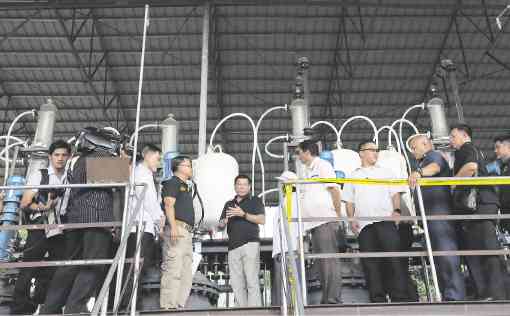
PRESIDENT Duterte inspects a “shabu” laboratory found in Arayat town in Pampanga province last month. JOAN BONDOC
CITY OF SAN FERNANDO—How did Chinese suspects manage to build what is reckoned to be the biggest “shabu” (methamphetamine hydrochloride) laboratory in the country? And who conspired to keep it hidden in Arayat town in Pampanga province?
In asking these questions, Gov. Lilia Pineda set the tone of the investigation being conducted by the provincial government and the police into the background of the laboratory that was discovered at the foothills of Mt. Arayat on Sept. 22.
The investigation, which began on Monday, gathered village leaders and farmers in Barangay Lacquios and neighboring Barangay San Juan Baño, both in Arayat.
The investigation also questioned a watchman and an official of the National Irrigation Administration (NIA), Arayat policemen, local government employees and Mayor Bonifacio Emmanuel Alejandrino.
Jesus Supan, village chief of Lacquios, said neither he nor the council had given clearance to the facility that was passed off as a piggery and corn crushing plant.
The landowner and the company supposedly operating those businesses have not applied for any permit.
Since February 2016, Chinese men either drove or rode 10-wheel trucks that passed the gates of Cong Dadong Dam en route to the compound at daytime, said Hejohn Gabriel Jr., a NIA watchman.
He said the trucks carried tires and sacks. But Gabriel said he did not inform the police about the Chinese he saw in the area because he assumed they were engaged in legitimate business there.
The presence of the Chinese was known at least in San Juan Baño because two women had been dating some of the men. But no official inquired about the nature of their business. In the Sept. 22 raid, only one of five Chinese suspects was arrested.
Nobody could tell when the shabu laboratory was built. Farmers said the compound was first fenced off with aluminum sheets, which were later replaced with hollow blocks. No villagers were hired to build the concrete fence or the three-story house there.
Two undercover policemen said they had placed the compound under surveillance in September and had recommended that the Bureau of Fire Protection and sanitary inspectors inspect the property.
The inspectors discovered the shabu-making equipment. Police said the facility can produce 400 kilograms of shabu daily.
The compound had existed in 2015 because a census taker recounted seeing sacks of corn at the structure. Residents, that time, complained that tires were being burned there to recover oil, according to an official in San Juan Baño. The town council held a hearing and stopped the burning of tires.
Alejandrino said the roof was being installed when he inspected the compound in February.
As for the property, the mayor said it used to be owned by Agnes Gojingo. It was sold to Jocelyn Balago of Laguna province and was later bought by Sonny Co. But the paper trail has not established how the lot was bought by Sunday Chua, now the subject of a manhunt.
Leopoldo Maniego, operations and maintenance chief of Cong Dadong Dam, said the Chinese suspects may not have passed the gates of the dam, using instead any of the two dirt roads leading to the compound.
“Let’s have a sense of duty here. We need to tell our fellow Kapampangan the truth. We need to find at what levels the lapses happened,” Pineda said.